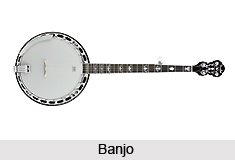 The banjo is one of the first jazz instruments. It is originally an African instrument brought to the United States through the slave trade. Though the banjo is commonly associated with country, folk and bluegrass music, it has historically occupied a very important placed in African American traditional music, as well as in the minstrel shows of the 19th century. African Americans exerted a strong, early influence on the development of both country and bluegrass through the introduction of the banjo, and as well through the innovation of musical techniques.
The banjo is one of the first jazz instruments. It is originally an African instrument brought to the United States through the slave trade. Though the banjo is commonly associated with country, folk and bluegrass music, it has historically occupied a very important placed in African American traditional music, as well as in the minstrel shows of the 19th century. African Americans exerted a strong, early influence on the development of both country and bluegrass through the introduction of the banjo, and as well through the innovation of musical techniques.
The sound board of the banjo is a flat tambour or drum-shape covered with parchment. The neck is proportionally long and fretted, and the back of the neck ends in a pegbox. There are three sizes of banjo, the tenor, bass, and long-necked banjo. Most banjos have four strings, but there are banjos with five strings, the fifth being relatively short. This fifth string is strung on the bass side, and a melody can be played on it with the thumb. The modern banjo comes in a variety of forms, including four- and five-string versions. A six-string version, tuned and played similar to a guitar, has been gaining popularity. The body, or "pot", of a modern banjo typically consists of a circular rim (generally made of wood), a metal tone ring, and a tensioned head, similar to a drum head. Traditionally the head was made from animal skin, but is often made of various synthetic materials today. Some banjos have a separate resonator plate on the back of the pot, while others have an open back. Electric banjos are also available.
Banjo strings are strummed or plucked, the player often using one or more plectrums attached to the finger tips, the so-called "fingerpicks." The banjo is also played solo or in ensembles to accompany singing. In almost all of its forms, the banjo`s playing is characterized by a fast arpeggiated plucking, although there are many different playing styles. Recently, the banjo has enjoyed inclusion in a wide variety of musical genres, including pop crossover music, indie rock and Celtic punk.
The Indian version of the banjo is the bulbul tarang. It is made of a number of strings which are laid across a keyboard. Instead of the keys being played directly, they are pressed with a series of keys, like a piano. Sometimes, these keys are even similar to a piano keyboard, though they also often resemble typewriter keys. The instrument can be tuned to different pitches as desired. However, rendering it multi-tonic makes it more difficult to play. The bulbul tarang is most commonly played as accompaniment to singing. The bulbul tarang is most popular among folk musicians and children due to its low price and easy availability. It is a commonly found instrument in India.




















